In this issue:
- Director’s Corner
- Coherence: a puzzle that keeps on giving
- Development of a high-current titanium beam for superheavy element production
- LEGEND-200 Enters Data Production Phase
- sPHENIX MVTX Detector Started Commissioning
- Inclusion, Diversity, Equity and Accountability Moments
- Fragments
-
Director’s Corner
This spring has been very eventful. A highlight was the special Award Ceremony on June 6 at Berkeley Lab for the 2023 Enrico Fermi Presidential Award winners Darleane C. Hoffman and Gabor Somorjai. We were able to celebrate this event and a number of scientific highlights on the newly established NSD Twitter account (@LBNLNuclearSci).
This issue provides insights on why coherent photonuclear interactions in ultra-peripheral collisions (UPCs) at ALICE and STAR provide physics opportunities while also presenting a puzzle for our theoretical understanding of coherent and incoherent photoproduction. This issue also provides updates on several exciting technical developments spearheaded by NSD that are coming to fruition. The development of high intensity titanium ion beams at the 88-Inch Cyclotron is advancing in preparation for forthcoming experiments to produce superheavy elements at the Berkeley Gas-Filled Separator (BGS). The LEGEND-200 neutrinoless double beta decay detector is starting its data taking phase at Gran Sasso, Italy. LBNL has produced the signal readout electronics which are showing superb performance. Finally, the sPHENIX experiment at the Relativistic Heavy Ion Collider (RHIC) has started its commissioning phase. The most inner part of sPHENIX is the MVTX vertex tracking detector which was assembled at LBNL and will enable the precision measurements of heavy quark production to study the Quark-Gluon Plasma (QGP).
These are just a few examples of the broad spectrum of exciting science and advanced technological developments led by NSD. These developments utilize LBNL’s unique expertise and infrastructure platforms. Another example in this context is GRETA, the Gamma-Ray Energy Tracking Array, which went through a successful Independent Project Review by the DOE Office of Project Assessment and is making significant progress as the review team could see during its tour (see photo).

The division was also strongly engaged in June’s Pride Month activities from the Lambda Alliance Flag raising on June 1 to the San Francisco Pride Parade, taking on critical roles such as staffing the Berkeley Lab booth, driving and being on the lab’s truck with science experiments, and being part of the lab’s parade contingent. It was great to see such a great engagement by everyone.
Finally, this issue also reports on the recent 2023 arXiv Accessibility Forum that addressed the access needs of people with disabilities in using the arXiv preprint server.
Sincerely,

-
Coherence: a puzzle that keeps on giving
In a recent paper1 published in Phys. Rev. C, NSD Senior Scientist Spencer Klein pointed out an intriguing puzzle associated with the observation of coherent photonuclear reactions.
The concept of coherence is well known to most physicists, from lasers, coherent light sources, and diffraction patterns. One adds the amplitudes for the identical process to occur on different targets and then squares; the cross-section scales as the square of the number of targets. This squaring has an important consequence for relativistic heavy-ion collisions: the cross-sections are large. Coupled with the charge-squared photon flux, the cross-sections for coherent photonuclear interactions in ultra-peripheral collisions (UPCs), interactions without hadronic interactions, are large – 7 barns for 0 photoproduction on lead at the LHC, similar to the total hadronic cross-section. UPCs have become an important technique for studying high-energy photoproduction. At the LHC, UPCs reach higher -p energies than the HERA ep collider, and orders of magnitude higher -Pb energies than fixed-target experiments. Measurements of J/ production in Pb collisions, like the event in Fig. 1, show that gluon saturation is moderate at Bjorken-x 10-3, comparable to the predictions from the leading-twist approximation and near the mid-point of nuclear parton distribution parameterizations.
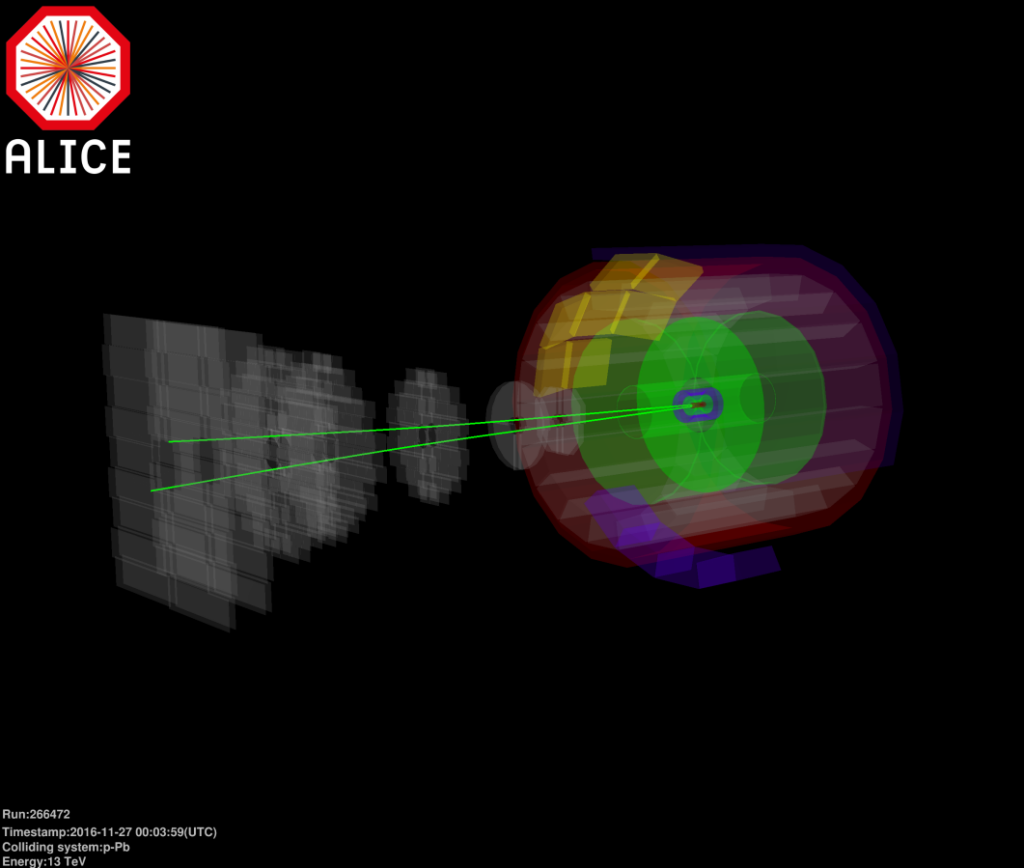
Figure 1. A candidate UPC event in ALICE, with two muons in the forward spectrometer, in an otherwise empty detector. The new ALICE Run-3 streaming data acquisition system will greatly boost UPC data collection by eliminating the previous bottleneck – a trigger to collect low-multiplicity UPC events, while rejecting most backgrounds. For STAR, the main UPC triggers had to require neutrons in their zero-degree calorimeters in addition to low–multiplicity in the central detector. The neutrons come from nuclear excitation via the exchange of additional photons, as shown in Fig. 2. Multiphoton exchange is expected at relatively small impact parameters.
And therein lies the puzzle highlighted by Klein. Quantum mechanically, coherence requires that the target nucleus remain in the ground state – the Good-Walker paradigm. Nuclear excitation violates the ground state requirement, but a coherent enhancement is still observed. Coherence can be explained semi-classically, by adding the amplitudes to interact with each target, with the usual propagator, but not in a fully quantum approach. This puzzle remains unresolved, but might be explained with a higher-order calculation.

Figure 2: Photoproduction accompanied by mutual Coulomb excitation occurs predominantly via three-photon exchange – one to produce the 0 and one to excite each nucleus. 1 The arXiv preprint of the article can be found here.
-
Development of a high-current titanium beam for superheavy element production
The ion source and operations groups at the 88 Inch Cyclotron are developing a high-current titanium beam to be used for the production of superheavy elements. In recent years, the 88 Inch Cyclotron delivered over two particle microamps (particle current is electrical current divided by beam charge state) of 48Ca using the superconducting ECR ion source VENUS. High currents of this beam were essential for reasonable superheavy element production rates, and the mass measurements of produced particles using these beams received significant press [1]. A promising path toward the production of undiscovered superheavy elements requires switching from 48Ca to 50Ti with similar beam currents.
Acceleration of 50Ti should be similar to 48Ca, however the beam production by the source is considerably more difficult. Ion beams are extracted from a plasma in VENUS, and beams can be made of anything that can be added to the plasma without destroying it. High-current metal beams are often produced by heating the metal in a small oven until it sublimates gaseous material into the plasma. Fig 1. shows the resistive “boat” ovens that were used for the recent titanium beam production. Inexpensive blank “boats” (a) are modified with holes for mounting and a wire support to secure the titanium metal (b). Electric currents run through the oven and titanium. VENUS’ high magnetic fields lead to strong Lorentz forces on these objects and can distort the oven. A contorted oven used in these recent runs in VENUS is shown in (c).
Figure 1: Resistive “boat” ovens were used for recent titanium beam production. The required temperatures for sublimation are much higher for titanium (~1700 ℃ vs. ~600 ℃ for calcium), which introduces engineering difficulties. More importantly, titanium not captured by VENUS’ plasma coats vacuum walls and reacts extremely strongly with other gasses used in the plasma leading to source instabilities.
During a development run in March focusing on oven optimization and improved cyclotron efficiency, over 1.4 particle microamps of 48Ti were extracted from the cyclotron at energies sufficient for superheavy element production—a result that appears to significantly lead other laboratories trying to do the same. Natural titanium was used for these tests (74% 48Ti) as isolated 50Ti is considerably more expensive. It is expected that both beam current and material consumption efficiency will increase when using refined titanium.
This work was led by Janilee Benitez with Jaime Duran, Damon Todd, and Dan Xie from the ion source group at the 88-inch Cyclotron.
[1] J.M. Gates, G.K. Pang, J.L. Pore, et al., “First direct measurements of superheavy-element mass numbers.” Physical Review Letters 121, 222501 (2018). [DOI: 10.1103/PhysRevLett.121.222501]
-
LEGEND-200 Enters Data Production Phase
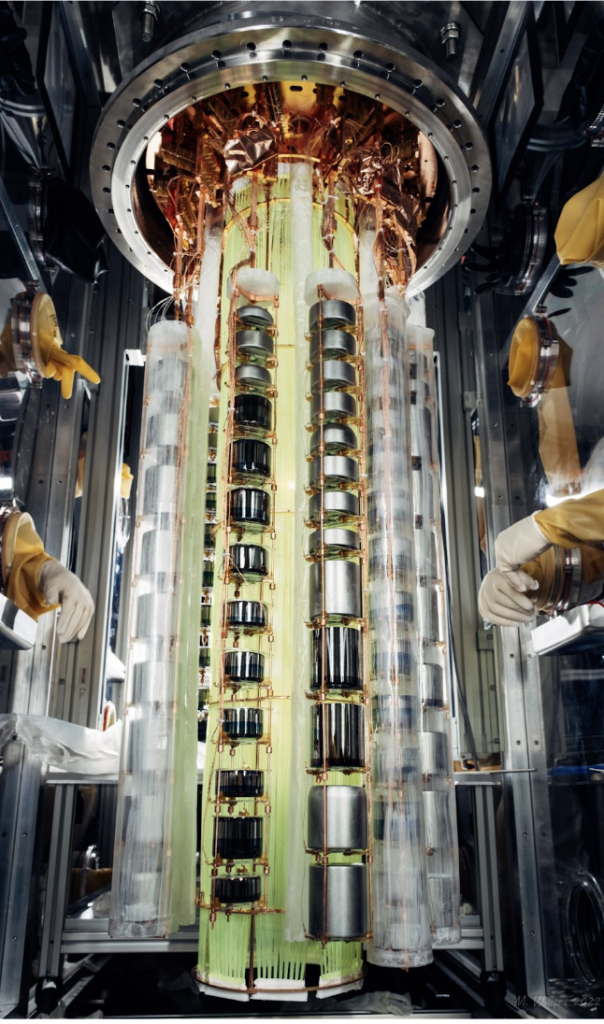
Figure 1: The assembled 76Ge-enriched detector strings in the LEGEND-200 experiment at LNGS. Photo courtesy of Michael Willers (Technical University of Munich). The first phase of the LEGEND experimental program — LEGEND-200 — has entered its production data-taking phase recently.
The LEGEND project was the amalgamation of two demonstrator experiments — GERDA in Europe and the MAJORANA DEMONSTRATOR (MJD) in the US — into a next-generation tonne-scale neutrinoless double-beta decay (0νββ) experiment. Its first phase, LEGEND-200, reuses the GERDA cryostat in Hall A of the Laboratori Nazionali del Gran Sasso (LNGS) underground laboratory in Italy to house 200 kg of 76Ge-enriched high-purity germanium (HPGe) detectors. Its sensitivity to 76Ge half-life is expected to be over 1027 years. Fig. 1 shows the partially completed array of 76Ge HPGes in LEGEND-200. The second phase, LEGEND-1000, will extend the discovery sensitivity tenfold to over 1028 years with approximately one tonne of 76Ge-enriched detectors. LEGEND-1000 will explore the hitherto uncharted inverted mass-ordering territory of the neutrino mass. NSD is responsible for producing and delivering the signal readout electronics for LEGEND-200. The NSD team adapted the design of the MJD low-mass front-ends (LMFE) [1] for their operation in liquid argon and built ancillary electronics to control their operation outside the cryostat. Scientists from the Università degli Studi di Milano and INFN Milano led the development and production of the charge-sensitive amplifier that augments the LMFE operation in liquid argon.Fig. 2 shows an LMFE, which is installed adjoining an HPGe detector to increase the fidelity of its minuscule signal. The LMFEs’ proximity to the HPGe detectors places severe radiopurity constraints; they must also operate reliably with low power consumption in liquid argon. Besides a bare junction field effect transistor on its substrate board, there is no other active electronics component on the LMFE.
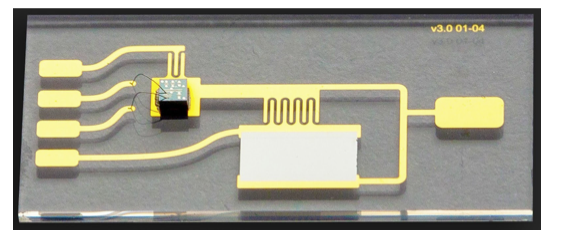
Preliminary calibration results of LEGEND-200 demonstrate the superior performance of the HPGe readout electronics system. Fig.3 shows the energy resolution (measured as full-width-at-half-max) at the 0νββ signal energy of 2039 keV for different types of HPGe detectors at various masses. The readout system’s performance is on par with those HPGe detectors used in MJD (red data points labeled as “PPC” in the figure) [2], improves on the “BEGe” and “COAX” detectors used in GERDA (orange and green data points) [3] while demonstrating good performance of the larger “ICPC” detectors, the baseline HPGe detector type for LEGEND-1000.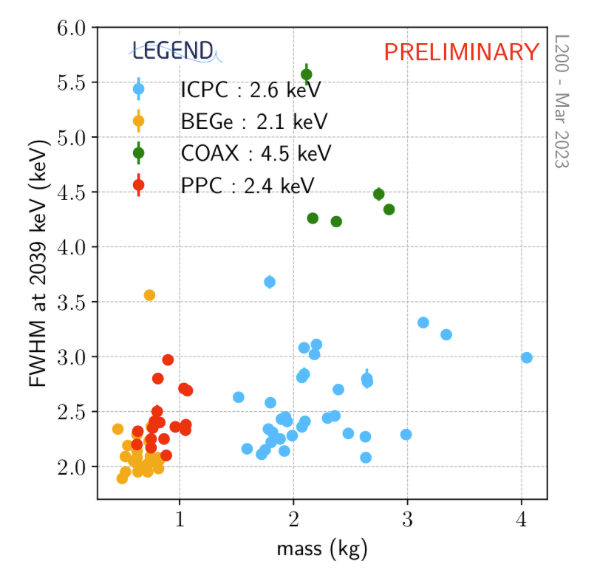
Figure 3: Energy resolution of the LEGEND-200 HPGe detectors. This figure shows the performance of HPGe detectors of different types at various masses. See text for details. The LBNL LEGEND-200 team includes research scientist Alexey Drobizhev, project scientist Bjoern Lehnert, senior staff scientist Alan Poon, and postdoctoral fellow Ann-Kathrin Schuetz from NSD; and engineers Rebecca Carney and Marcos Turqueti from the Engineering Division.
[1] The Majorana Demonstrator readout electronics system, N. Abgrall et al., JINST 17 (2022) 05, T05003, DOI:10.1088/1748-0221/17/05/T05003.
[2] Final Result of the MAJORANA DEMONSTRATOR’s Search for Neutrinoless Double-β Decay in 76Ge, I.J. Arnquist et al., Phys. Rev. Lett. 130 (2023), 062501, DOI:10.1103/PhysRevLett.130.062501.
[3] Final Results of GERDA on the Search for Neutrinoless Double-β Decay, M. Agostini et al., Phys. Rev. Lett. 125 (2020) 252502, DOI: 10.1103/PhysRevLett.125.252502. -
sPHENIX MVTX Detector Started Commissioning
The MAPS-based VerTeX (MVTX) detector has been recently installed into the center of the sPHENIX experiment at BNL’s Relativistic Heavy Ion Collider (RHIC) in late March. The sPHENIX detector has been under commissioning and together with the STAR detector started RHIC’s 23rd-year operation.
The sPHENIX MVTX detector is based on Monolithic Active Pixel Sensors (MAPS) technology that was pioneered in the STAR’s HFT project and further developed for the ITS upgrade of the ALICE experiment at CERN. The physics goal of the MVTX detector is to conduct precision measurements of heavy quark production in order to characterize the detailed structure and properties of Quark-Gluon Plasma (QGP) matter created in heavy-ion collisions. LBNL scientists from the Relativistic Nuclear Collision (RNC) program led the detector construction, assembly, and survey over the past few years and completed it last summer. The detector was shipped to BNL last fall with all components intact.
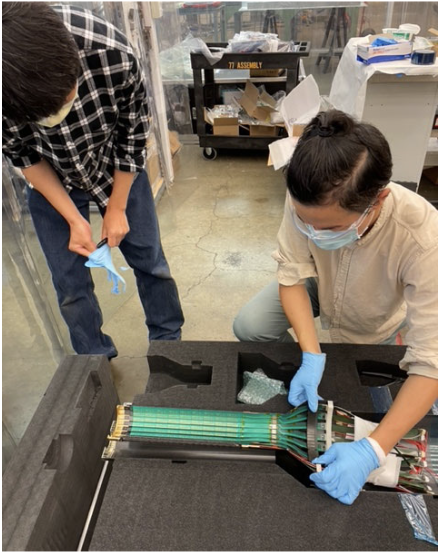
Figure 1: NSD’s staff scientist Yuan Mei (left) and postdoc Ho San Ko (right) assembling the MVTX half barrel detector. The MVTX detector, the most inner subsystem, was the last component installed into the sPHENIX experiment with the help of physicists and engineers from BNL, LANL, LBNL and MIT in late March. The RHIC machine started cool-down in early May. This year’s RHIC run is planned to dedicate significant time for the sPHENIX detector commissioning and is scheduled to finish at the end of September. Fig. 1 shows NSD Staff Scientist Yuan Mei and postdoc Ho San Ko working on the assembly of the MVTX half barrel detector.
-
Inclusion, Diversity, Equity and Accountability Moments

IDEA: Towards More Accessible Research Papers
On April 17, 2023, arXiv.org, a widely-used preprint server, held the 2023 arXiv Accessibility Forum. The purpose of this forum was to educate attendees on the access needs of people with disabilities, discuss the work that needs to be done to meet those needs, and to plan who is responsible for doing that work, all within the context of academia. As arXiv is a preprint server, the focus was primarily on research papers, which create particular barriers to blind researchers. The forum was attended by NSD postdoc Tyler Hague who provided a report to the Division at a recent staff meeting.
The most readily apparent barrier is the consumption of figures and graphics within a paper. The needed solution for this is to include alt-text (short-form, embedded into the image) and/or extended descriptions (longer-form, typically in a different location). These are additional text that describes what is seen in the image and what underlying message is interpreted from it. This text is in contrast to the image captions which tell the reader what the image is without telling them what it looks like. An added benefit that was discussed is that the process of describing a figure often forces authors to more deeply consider the intended takeaway of a figure as well as why that figure is useful for the publication.
Google Docs has this functionality, as shown below:
The other primary barrier discussed was that of software and file formats. The most common tool used for a blind person to interface with a paper is called a “screen reader”. At its core, this software takes the document as an input and then audibly speaks the text that it reads. When a screen reader encounters an image, it looks for alt-text to speak instead. PDF documents often create difficulties for these tools, as they rely on specific PDF tags to indicate where the text is located.
Until very recently, LaTeX completely omitted these tags from the final document. LaTeX still has no alt-text implementation, but that is in development (per the developers present at the forum). However, this still doesn’t solve the problem as many PDF readers discard the tags when reading in a document. While there is a push to improve the landscape of PDF documents, there was also discussion of moving towards HTML based papers. HTML is the gold standard for accessible documents as it is necessarily tagged and supports all major accessibility designs. Many journals have begun creating HTML versions of papers and arXiv is moving to merge their implementation of this, ar5iv.org, with their main repository soon. The HTML version of a paper can be reached simply by replacing the X with a 5 in the URL (example: original, HTML). Right now anyone interested in helping this effort can take the concrete step of checking the HTML versions of their papers for conversion errors and reporting them to the developers using the issue tracker linked at the bottom of the page, which looks like this:
For researchers who attended the forum, the primary expectation was to practice, teach, and normalize the inclusion of alt-text and extended descriptions to ensure that research is accessible. To paraphrase an organizer of the conference: once we are aware of the needs of those in our community, to choose not to meet them is to choose to exclude them.
Recent DEI topics @ NSD Staff Meetings
- April 18, 2023 Autism Awareness Month and Neurodiversity
- May 2, 2023 Mental Health Awareness
- May 16, 2023 Report from the arXiv Accessibility Forum 2023
- May 30, 2023 Pride Month Activities
- June 13, 2023 Implicit Bias
Luminary Cards
To recognize their efforts in the area(s) of Inclusion, Diversity, Equity, and Accountability, the following people received a Luminary Card: Clara Barker (Oxford University), Teresa Calarco, Morgan Morse, Liz Stuart
Fragments
Norman K. Glendenning sadly passed away on September 5th 2022 at the age of 91, after a long illness. He was a distinguished nuclear theorist and a founding member of the Nuclear Theory Group in the NSD. An obituary written by James Symons, Xin-Nian Wang, and Fridolin Weber was recently published by Physics Today and can be found here.
Pioneering NSD scientist Darleane C. Hoffman received the 2023 Enrico Fermi Presidential Award, one of the most prestigious science honors bestowed by the U.S. government, in a special ceremony at Berkeley Lab on Tuesday, June 6th. Hoffman, a nuclear chemist, was honored for her scientific discoveries that advanced the field of nuclear and radiochemistry, for distinguished service to the DOE’s missions in national security and nuclear waste management, and for her sustained leadership in radiochemistry research and education. More details of Darlene’s award, and a video of the ceremony can be found here.
NSD postdoctoral researcher Emil Rofors represented Berkeley Lab at the 2023 National Postdoc Association Annual Conference in Philadelphia. Emil is a postdoctoral researcher in the Applied Nuclear Physics program and a member of the LBNL Postdoc Association board.
NSD established a Twitter account (@LBNLNuclearSci) which is being used to share regular highlights from across the Division and the Laboratory.
NSD welcomes new hires Erich Leistenschneider (Staff Scientist), Ashish Pandav (Postdoctoral Researcher), and Lisa Schlüter (Postdoctoral Researcher).
We are also pleased to host summer interns from a range of programs including the SULI program, SURF, the NNSA Minority Serving Institution Partnership Program, the NSD-led GREAT-NS initiative, and through the N3AS Physics Frontier Center. We welcome Phoebe Andromeda, Julia Dreiling, Brandon Wilson, Israel Galeana, Patrick Francisco, Elijah Dolz, Laylah Chacon, Griffin Rhoads, Samantha Goldberg, Hong Joo Ryoo, Tiana French, Yajat Thanawala, Birgitta Biendarra, Declan Hoban, Bryce Benun, Wan Siyang, Siddhant Mal, Annabelle McCutcheon, Charles- Yu Hong Chan, Jasmine Crawford, Henry Purcell, Malika Golshian, Brandon Lem, Paul Shin, Ashley Rincon, Dylon Fleming, Eddy Alderete, Emma Lynch, Ethan Skeens, Hong Joo Ryoo, Joseph Koplowitz, Sawyer Kaplan, Diego Hernandez Kent.
We also welcome visiting faculty Prof. Wing To who will be working with Gabriel Orebi-Gann.